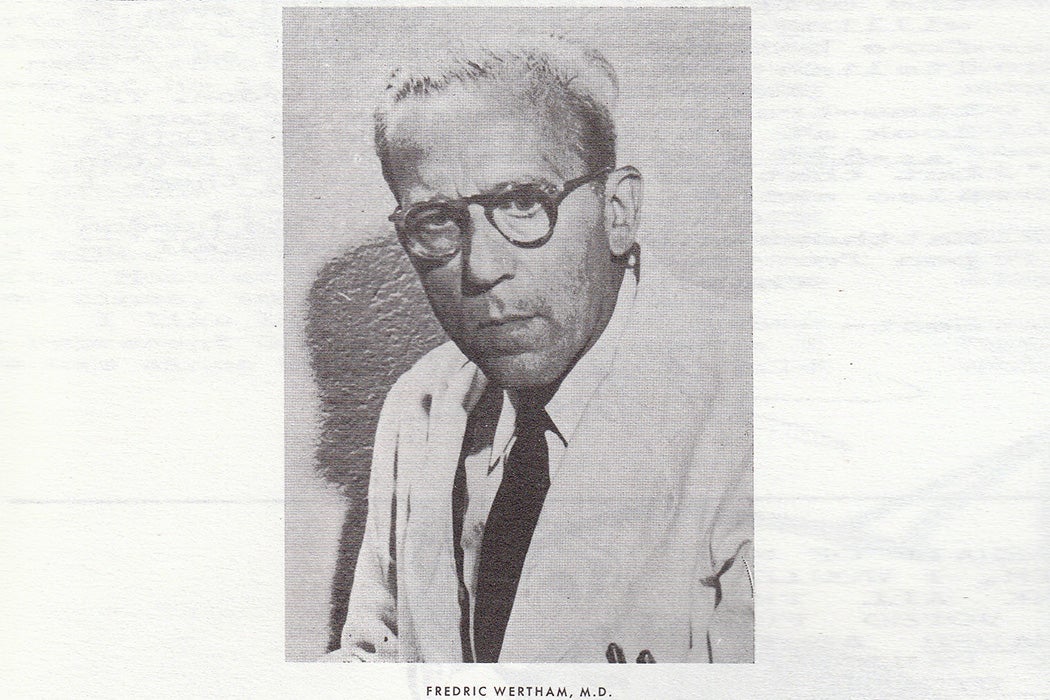Fredric Wertham is something of a cartoon villain in the historical imagining of 1950s America, akin to one of those squares warning against the dangers of “reefer madness.” In an era of McCarthyism and looming nuclear Armageddon, Wertham, a German-born psychiatrist, was the serious face of the crack-down—on comic books.
In his book The Seduction of the Innocent: The Influence of Comic Books on Today’s Youth (1954), Wertham argued that comic books were turning kids to delinquency and deviance via lurid horror, graphic violence, and perverse sex. Claiming that Batman and Robin were secretly homosexual, Wonder Woman an S&M lesbian, and comics in general were likely to turn “normal” middle-class children into criminals and “sex maniacs,” Wertham struck a reactionary chord in white America.
As it happens, his evidence was “manipulated, overstated, compromised, and fabricated,” as comics scholar and librarian Carol L. Tilley writes, but the book was nonetheless hugely influential. Even as other psychiatrists considered his anti-comics crusade an embarrassment to the discipline, Wertham was the star witness at the US Senate’s Sub-Committee on Juvenile Delinquency hearings on the comic books industry in April 1954.
Like Hollywood execs decades before, comic book publishers responded to the moral panic by self-censoring themselves. The resulting Comics Code Authority (1954) of the Comics Magazine Association of America was a set of rules which lasted, in revised form, until this century.
Wertham’s “campaign against comics evokes a moment typified by conformity, censorship, blacklisting, and grey-flannel suits,” writes historian Dennis Doyle. But like many a comic book superhero, Wertham had a secret identity under that gray flannel suit. In the midst of the domestic Cold War against dissent, Wertham epitomized “a carefully crafted public image [that] enabled some subversive institutions to avoid the blacklist and pursue their missions.”
An avowed anti-racist, Wertham teamed up with author Richard Wright in 1946 to open the Lafargue Mental Hygiene Clinic in Harlem, New York City. They wanted to offer mental health care to an extremely under-served community.
“Wertham and a cadre of young black Harlemites envisioned the clinic as a weapon against institutional racism,” writes Doyle.
At a time when [B]lack access to quality psychotherapy was limited, this subversive clinic—named after Karl Marx’s French Communist son-in-law, Paul Lafargue—offered it to the emotionally ill of all races, often at no charge.
Money was always a problem for running the part-time clinic. When Wertham joined the anti-comic books crusade, conservative supporters, excited to have him on their side in the culture war, became contributors. In the age of “massive resistance” to court-ordered desegregation, Wertham’s anti-comics allies “were unaware of [the clinic’s] antiracism, its [B]lack staff, and its [B]lack patient body.”
This is because, through the mass media likes of Ladies’ Home Journal and Readers Digest, the clinic appeared “not as a struggling, interracial doctor’s office serving the [B]lack poor but as a research facility studying the effects of comic books on white, middle-class children.”
Wertham was unusual: he believed Black Americans “were the psychological equals of whites and deserved a race-neutral psychiatric approach.” As such, he didn’t identify his patients/study subjects by race. Those blinded by their racism assumed that he must be referring to white people when he wrote or talked about the clinic.
“The interracial Lafargue Clinic’s public image had been filtered through race-neutral language that Wertham’s fans misinterpreted to mean the absence of African Americans,” explains Doyle.
Weekly Newsletter
This led to some awkwardness. Black staffers would turn up at all-white PTA meetings, whose attendees were expecting a white speaker from the Lafargue Clinic. The “unexpected blackness” of the speakers—psychologists/teachers Elaine Vaughn and Del Jenkins and social worker Robert Johnson—came up against attitudes like those of a white Connecticut father who described his misbehaving son as being “like from another race.”
Too many incidents like this ultimately revealed what was hiding in plain sight. At the same time, the winding down of the comic book panic by 1957 lessened conservative interest in Wertham. Meanwhile, the Lafargue Clinic “never enjoyed an active relationship with the civil rights movement,” writes Doyle, even though Wertham’s work on the effects of segregation was cited in the legal challenge to segregated education. Few on the liberal/left spectrum, meanwhile, considered the censor an ally. The Lafargue Clinic shut down in 1959—when it was still charging the twenty-five-cent fee it had opened with in 1946, a nominal amount often not collected by staffers.
Teaching Tips
Support JSTOR Daily! Join our membership program on Patreon today.







